[ad_1]
The difference between success and failure in Forex / CFD trading is highly likely to depend mostly upon which assets you choose to trade each week and in which direction, and not on the exact methods you might use to determine trade entries and exits.
So, when starting the week, it is a good idea to look at the big picture of what is developing in the market as a whole, and how such developments and affected by macro fundamentals, technical factors, and market sentiment. There are a few valid medium-term trends in the market right now, which might be exploited profitably. Read on to get my weekly analysis below.
I wrote in my previous piece on 19th February that the best trade opportunity for the week was likely to be long of the S&P 500 Index (potentially for a long-term investment). Unfortunately, the S&P 500 Index fell by 2.03%. I also saw a long trade in the US 2-Year Treasury Yield if we see a daily close above 4.729%, but this did not set up until the last day of the week.
The news is dominated by a growing feeling that the US Federal Reserve will not be able to bring inflation down to its 2% target without raising interest rates to considerably higher levels. A few weeks ago markets were expecting a terminal rate of about 5.1%, but it now stands at about 5.6% and may be set to increase. The 2-Year Treasury Yield rose firmly last week, closing above 4.8% and in sight of its multi-year high made a few months ago. This sentiment was reinforced Friday when US Treasury Secretary Janet Yellen stated that US inflation is “not yet under control”, which is a complete reversal of what she was saying just a few months ago in October 2022. Additionally, Core PCE Price Index data came in higher than expected, suggesting that inflation has been increasing meaningfully over the past month.
This sentiment has had several effects:
- Stock markets are falling, with the S&P 500 Index closing below 4000 after falling by more than 2% over the week, while the NASDAQ 100 Index also fell.
- The US Dollar and US treasury yields are continuing to rise, having been in a bullish trend over the past few weeks.
- Many other “risk” assets, such as the Australian Dollar, are also trending lower.
Turning to the European Union, inflation concerns are also rising there as Euro-area core inflation data is not showing signs of a meaningful slowdown. This is leading to higher expectations concerning future ECB rate hikes.
The other major news has been concerning the imminent changeover of the Governorship of the Bank of Japan. Outgoing Governor Kuroda and incoming Governor Ueda have both made clear over the past few days that the ultra-loose monetary policy at the BoJ is here to stay, which saw the Yen weaken strongly on Friday.
There were some other significant data releases last week:
- US Preliminary GDP data came in a bit lower than expected, showing an annualized growth rate from last quarter of 2.7% compared to the 2.9% which had been expected.
- US Core PCE Price Index data came in higher than expected, showing a month on month increase of 0.6%, compared to the increase of 0.4% which had been widely expected.
- Canadian CPI data came in a bit lower than expected, showing a month-on-month increase of only 0.5% instead of the anticipated 0.7%.
- RBNZ Official Cash Rate & Monetary Policy Statement – the RBNZ made a hike of 0.50% which was expected, but also stated that further hikes were expected, which was seen as a hawkish tilt.
There were a couple of other data releases concerning the UK and Australia, but none of them contained any major surprises or moved the market significantly.
Rates of coronavirus infection worldwide again dropped last week for the ninth consecutive week according to official data, with the lowest overall numbers seen since May 2020, shortly after the start of the pandemic.
The coming week in the markets is likely to see a lower level of volatility than last week, as there are only a few major data releases due. They are, in order of importance:
- Bank of Japan Governor-Designate to Testify Before Parliament
- Australian CPI (inflation) data
- US ISM Services PMI data
- US ISM Manufacturing PMI data
- Canadian GDP data
- US CB Consumer Confidence data
The weekly price chart below shows the U.S. Dollar Index printed a strong bullish candlestick, a few weeks after having convincingly rejected the support level shown at 101.07, which typically signifies a continuing reversal of direction.
The candlestick is large and closed right on the high of its range, which is a bullish sign. Another bullish sign is that the Dollar is now trading above its level of 3 (but not 6) months ago. However, it is noticeable in the price chart below that the rise stopped right at the key resistance level at 104.93.
I do not like to trade against long-term trends, but there are increasing signs that we have a new long-term bullish trend in the US Dollar. It might reverse, but this will probably take some time, so I will be extremely cautious taking any trades against the US Dollar this week.
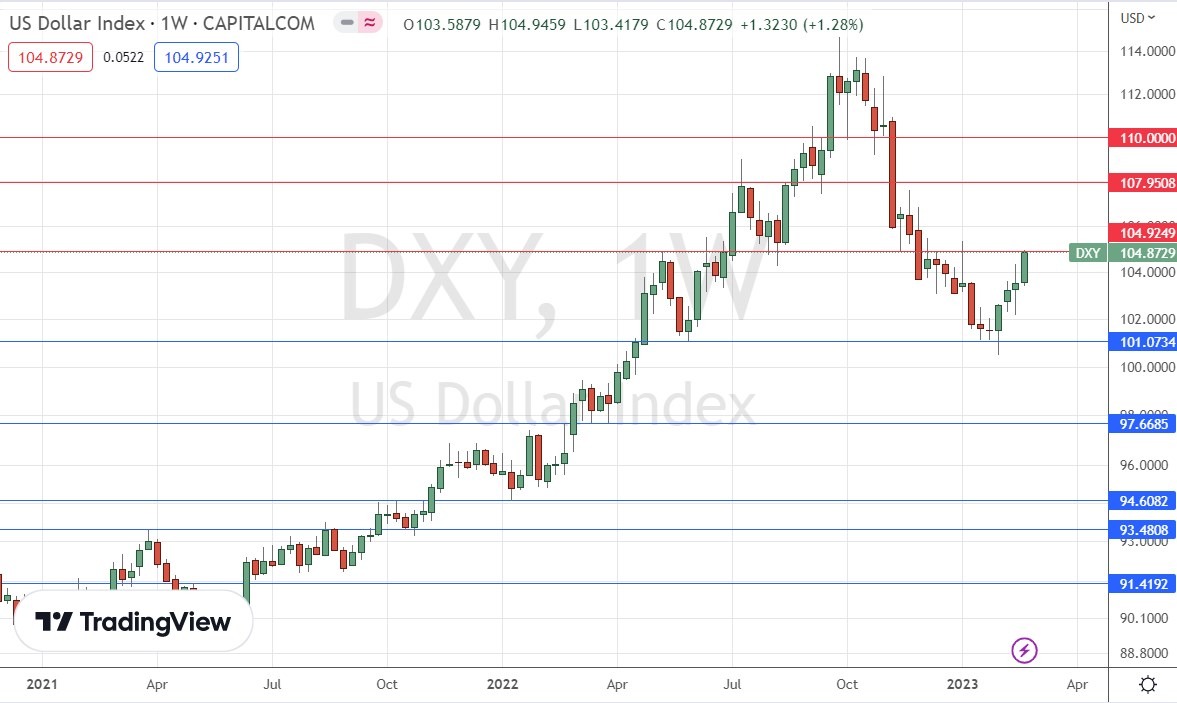
Last week saw the USD/JPY currency pair print another firm bullish candlestick, which closed right on its high. The US Dollar was again the strongest currency over the past week, while the Yen was the weakest, putting this pair in focus. The movement was driven equally by Yen weakness and Dollar strengths.
The former short-term bullish trend seems to have become a valid long-term bullish trend, with the price trading above its level of 3 months ago.
The trend is not well established or stable, but there could be good day trading opportunities here on the long side over the coming week, as the new Governor of the Bank of Japan appears keen to stick to the existing ultra-dovish monetary policy of his predecessor.
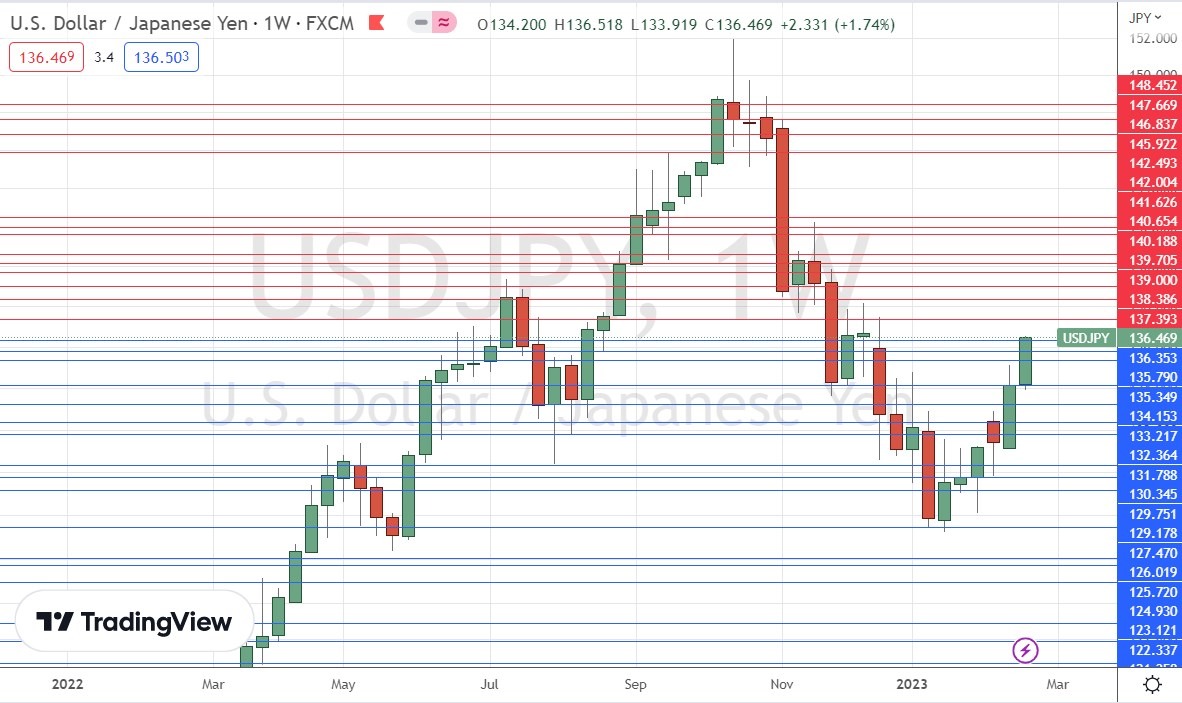
Last week again saw the S&P 500 Index fall, printing a fairly large bearish doji candlestick. Conditions seem to be becoming more bearish on increasing gloom over US interest rate hikes and a higher terminal rate.
The daily price chart still shows a valid golden cross (or bull cross), where the 50-day MA crosses over the 200-day MA, valid since Thursday two weeks ago. Such a cross historically indicates the beginning of a major bull move, so it could be a great long-term buy signal.
Another bearish feature is the close below 4000 which can be taken as a bearish sign. If the price trades below 3875 that would suggest, based on historical data, that a bull market is not going to take off any time soon.
It looks most likely that we will see the price continue to decline over the coming week. If we get a daily close above 4018 before 3875 is reached, that would be a bullish sign.
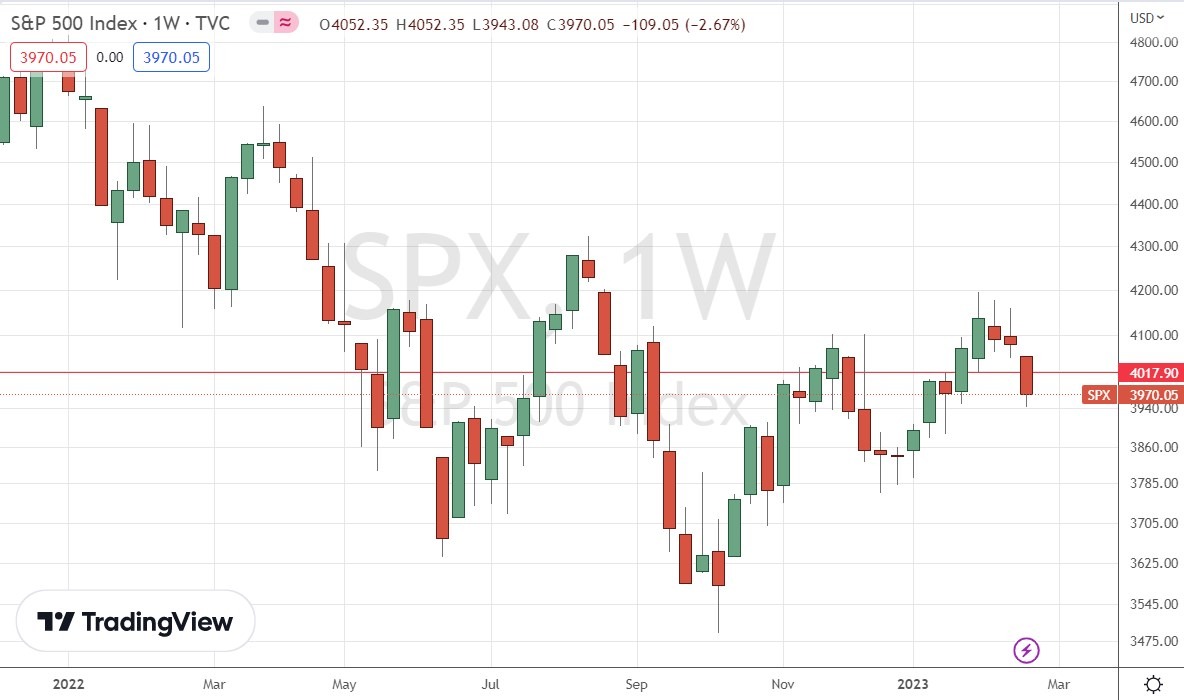
Last week saw the NASDAQ 100 Index print a bearish candlestick, as the price again failed to make a bullish breakout beyond the key resistance level at 12820.
It is worth noting that while the NASDAQ is very positively correlated with the wider S&P 500 Index, the NASDAQ is not showing a golden cross, unlike the S&P 500, and has been held for longer by an obvious resistance level. This suggests that the NASDAQ is looking relatively weak, so a bullish play should use the S&P 500 Index as a more appropriate vehicle. If you think the US stock market is about to break down and you want to trade short, the NASDAQ might be a better bet.
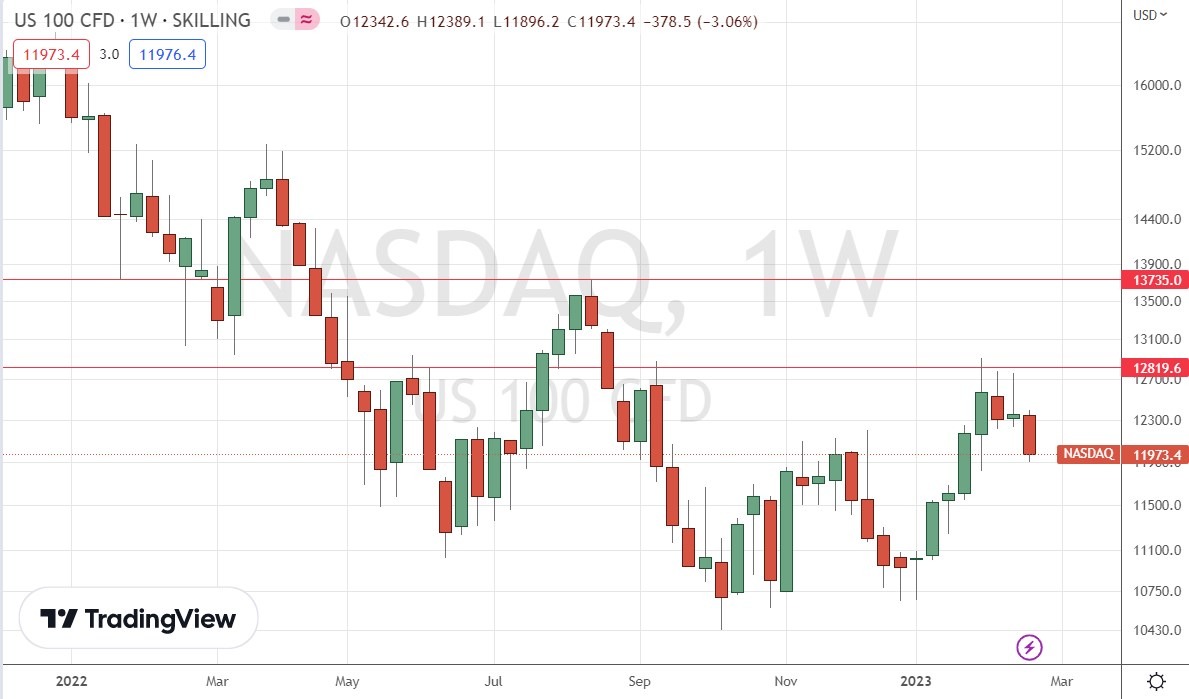
Us Treasury Yields rose again last week, notably the 2-year yield, after US economic data and statements/minutes from the Fed continue to show a hotter economy than had been expected, raising expectations for rate hikes.
Technically, the chart looks very bullish: we see the highest weekly close here made in years.
This could be a resuming trend as expectations of the terminal US interest rate rise, but I remain concerned that the 50-day moving average remains below the 100-day moving average.
I will not enter a long trade here until these moving averages cross, and the price makes a higher daily close.
Traders should note that this asset exists as a micro-future, which can be affordable for many.
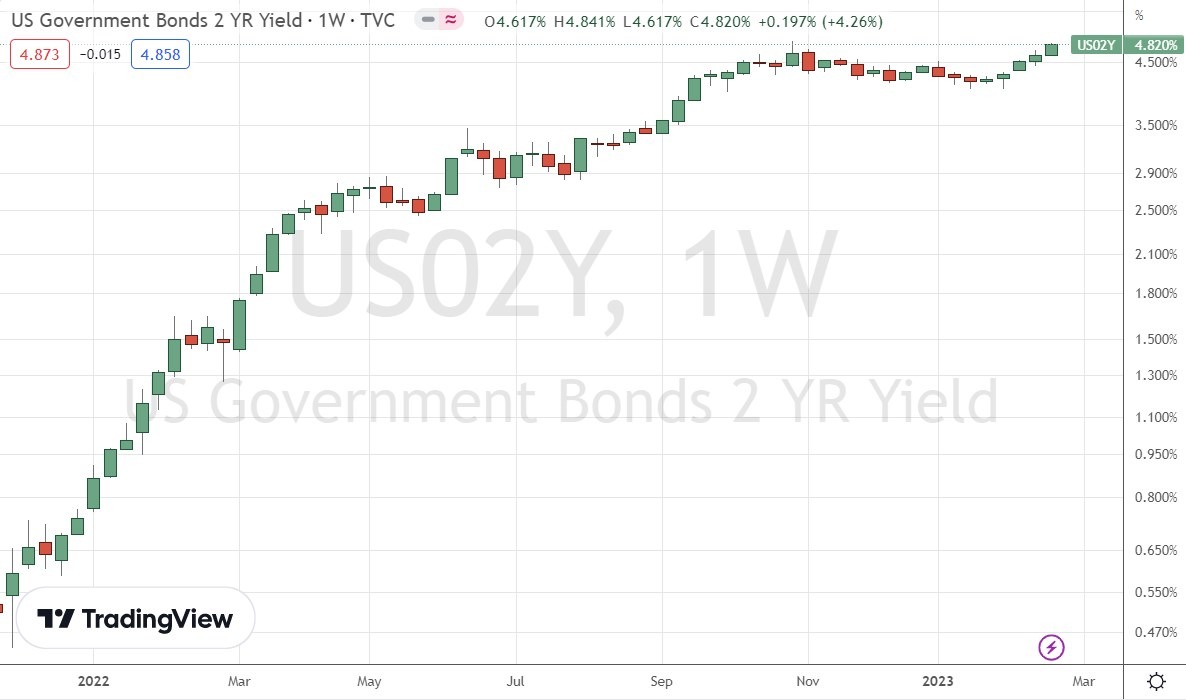
I think longer-term traders may be wise to sit on the sidelines this week. However, I see a long-term investment opportunity as valid in the S&P 500 Index following a daily close above 4018, and potential day trading opportunities in the USD/JPY currency pair on the long side. I also see a long trade in the US 2-Year Treasury Yield if we see the fast-moving average cross above the slower one with a new high at the daily close.
Ready to trade our weekly Forex forecast? Here are the best Forex brokers to choose from.
[ad_2]